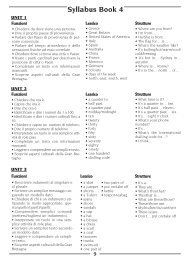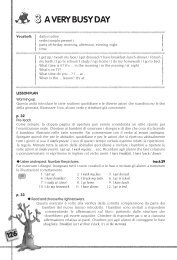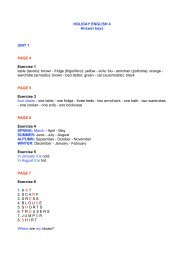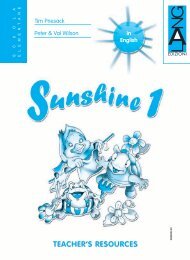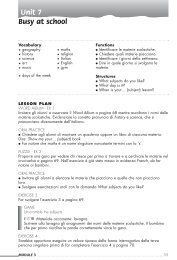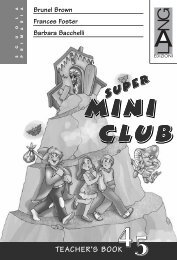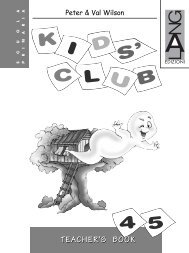Create successful ePaper yourself
Turn your PDF publications into a flip-book with our unique Google optimized e-Paper software.
LANGPrimaryHogmanay - Scottish New YearJoanna CarterBACKGROUNDew Year’s Eve is celebrated all around the world but perhaps the Scots have the lastNword on how to really celebrate it. In Scotland there is a long rich heritage associatedwith this event. There is even a special name for it Hogmanay.Until recently, the 31st of December was considered more important than Christmas inScotland. Many Scottish people had to work over Christmas in the past and so their winterholiday was at New Year when family and friends gathered for a party and exchanged kissesand presents, especially for the children. This occasion came to be known as ‘hogmanay’and the tradition still continues today. In origin it is a much, much older celebration,probably inherited from the Vikings, for whom observing the passing of the shortest day wasimportant.Why is it called Hogmanay?There is a lot of confusion overthe origin of the word hogmanay.Nobody knows the real reasonfor the name, but there are manytheories. Some say it comes froman Anglo Saxon word meaningHoly Month, others that it comesfrom the Gaelic oge maidnewhich means New Morning.There is even a modern dayinterpretation which is that itreally means Hug Many, as it isimportant to embrace and kissfriends and relatives aftermidnight!There are many ancient traditionsthat surround Hogmanay, that takeplace before and after midnight.Before MidnightBefore the bells strike midnight,it’s important to have the housevery clean and tidy and to besure that any rubbish has beentaken outside. Also all debts mustbe settled and nobody must oweanybody money. The idea of thisis that people clear out the oldyear and welcome in the youngNew Year on a happy note.After MidnightImmediately after the bells haverung, it’s traditional for people tocross arms and join hands in alarge circle to sing For Auld LangSyne. This song is now known allover Britain and in other Englishspeaking countries, but it wasoriginally written by Scotland’sgreatest poet Robert Burns, whooften wrote in dialect. For auldlang syne means in memory ofpast times.Should auld acquaintance be forgotAnd never brought to mindShould auld acquaintance be forgotFor the sake of auld lang syne.For auld lang syne, my dear,For auld lang syneWe’ll take a cup of kindness yet,For the sake of auld lang syne.First FootingAfter midnight it is alsotraditional to visit (or first foot)friends’ and neighbours’ houses.People should bring a gift ofwhisky, a lump of coal and something to eat: black bun, oat cakesor a delicious biscuit calledshortbread. Those who stay athome hope that the first over thedoor step or the first foot is a tall,dark and handsome man as thisbrings good luck! Many gifts areexchanged and people offer HetPints – a mix of a special beercalled ale, nutmeg, whisky, sugarand eggs!Recipe for Shortbread150 g plain flour150 g caster sugar100 g butterSieve the flour into a bowl. Addthe sugar. Rub in the butter. Themixture will be crumbly at first –continue until it clings togetherin heavy lumps. Put the mixtureon a lightly floured board.Knead it lightly. Roll it out to a20 cm circle and place on agreased baking tray. Prick overthe top with a fork and flute theedges with your fingers andmark into 8/10 portions. Bakefor 30 to 35 minutes at 170°cuntil cooked but not brown.Leave on the tray to coolslightly. Then lift off with a fishslice or similar and put it on acake rack to cool completely.Fire CeremoniesIn many parts of Scotland, thereare ceremonies with fires,fireworks and torch processionsat Hogmanay. Perhaps the mostspectacular ceremony takes placein Stonehaven, near Aberdeen.Here giant fireballs are lit andswung around on two metre-longLANGPrimarykeeping the teacher informed2



